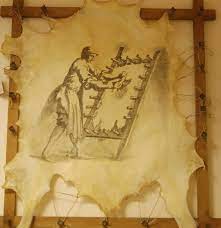This exhibition explores the art of leather of Turkey starting with 8000 BC.
The story begins with nomadic Asian roots found in Pazırık, continues with Catalhöyük in Anatolia and ends with the Republic of Turkey.
Journey of the Turks from Inner Asia to Anatolia (Asia Minor) incorporated many different centres of power and artistic traditions.
Influences can be traced from Asian roots mingled with the ancient civilizations of Anatolia like Hittites, Urartians, Phrygians, Ionians to the Byzantines, Seljuks, Oğuz tribes and Ottomans, and in which urban sophistications of the Türkmen and Yörük nomads all participated to create a colourful symphony.
These works of art passed down by earlier generations astound us with their diversity, glowing colour harmonies, skilful workmanship and striking designs.
Leather is an ancient profession in the country now known as Turkey, a land heir to two different traditions of tanning and leathergoods production.
The first tradition was that of the Mediterranean tanners who derived their experience from those of the Sumerians, Egyptians, and Hittites. The second leather tradition arrived with Turks who have created a fascinating leather art as they absorbed the diverse cultures and religions they encountered on their wanderings.
There is a long and arduous journey ahead of us: the lines in the poetry of Homer, the old Dede Korkut stories, the armor of Alexander the Great, the tradition by Ahi Evran, the Anatolian aphorisms: “The leather conceals the cheese, the man conceals the woman”.
We have decided to opt for the easier path and try to take a brief look at the adventure of leather in Turkey.
* scroll through the timeline using the arrows above, or go straight to the main menu
Asian Roots
-
Turks, Pazırık, Inner Asia 500 BC
Anatolian Civilisations
-
Domestication of Animals 8000 BC
-
Çatalhöyük 6500-5500 BC
-
Alacahöyük 2100-1900 BC
-
Hittites 2000-700 BC
-
Urartians 900-600 BC
-
Phrygians 750-300 BC
Phrygric Cap
Aesop’s Fables
-
Ionians 1050-30 BC
Parchment
Artemis Statute
Tragedy
Ilyada/Odysseus
-
Romans 30 BC-AD 395
-
Byzantium AD 395-1453
Book of the Eparch
Military Use of the Leather
Byzantine Shoe
-
Seljuk Turks AD 1040 – 1300
-
Ottoman Turks AD 1299 – 1922
Topkapı Palace Museum
Military Use of Leather
Maps (Portolans)
Bindings
Footwear: Boots, Shoes, Sandals
Kırkpınar
Karagöz/Hacivat (Shadow Theatre)
-
Turkish Language




















